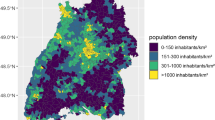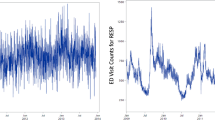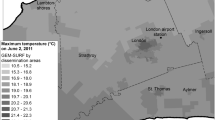Abstract
Several exposure metrics have been applied in health research and policy settings to represent ozone exposure, such as the 24 h average and daily 8 h maximum. Frequently, results calculated using one exposure metric are converted using a simple ratio to compare or combine findings with results using a different metric. This conversion, however, assumes that such a ratio is constant across locations and time periods. We investigated the appropriateness of this conversion method by examining the relationships among various forms of ozone concentrations (24 h average, daily 1 h maximum, and daily 8 h maximum) within and between communities for 78 US communities from 2000 to 2004 and compared results to commonly used conversion ratios. We explored whether the relationships between ozone exposure metrics differ by region, weather, season, and city-specific characteristics. Analysis revealed variation in the relationship among ozone metrics, both across communities and across time within individual communities, indicating that conversion of ozone exposure metrics with a standard ratio introduces uncertainty. For example, the average ratio of the daily 8 h maximum to the daily concentration ranged from 1.23 to 1.83. Within a community, days with higher ozone levels had lower ratios. Relationships among metrics within a community were associated with daily temperature. The community-average exposure metric ratios were lower for communities with higher long-term ozone levels. Ozone metric ratios differed by season because of the different rate of change of ozone metrics throughout the year. We recommend that health effects studies present results from multiple ozone exposure metrics, if possible. When conversions are necessary, more accurate estimates can be obtained using summaries of data for a given location and time period if available, or by basing conversion ratios on data from a similar city and season, such as the results provided in this study.
This is a preview of subscription content, access via your institution
Access options
Subscribe to this journal
Receive 6 print issues and online access
$259.00 per year
only $43.17 per issue
Buy this article
- Purchase on Springer Link
- Instant access to full article PDF
Prices may be subject to local taxes which are calculated during checkout






Similar content being viewed by others
References
Abbey D.E., and Burchette R.J. Relative power of alternative ambient air pollution metrics for detecting chronic health effects in epidemiological studies. Environmetrics 1996: 7 (5): 453–470.
Arbaugh M.J., Miller P.R., Carroll J.J., Takemoto B., and Procter T. Relationships of ozone exposure to pine injury in the Sierra Nevada and San Bernardino Mountains of California, USA. Environ Pollut 1998: 101 (2): 291–301.
Bell M.L., Hobbs B.F., and Ellis H. Metrics matter: conflicting air quality rankings from different indices of air pollution. J Air Waste Manage Assoc 2005a: 55 (1): 97–106.
Bell M.L., Dominici F., and Samet J.M. A meta-analysis of time-series studies of ozone and mortality with comparison to the National Morbidity, Mortality, and Air Pollution Study. Epidemiology 2005b: 16 (4): 436–445.
Bell M.L., Peng R.D., and Dominici F. The exposure–response curve for ozone and risk of mortality and the adequacy of current ozone regulations. Environ Health Perspect 2006: 114 (4): 532–536.
Gent J.F., Triche E.W., Holford T.R., Belanger K., Bracken M.B., Beckett W.S., and Leaderer B.P. Association of low-level ozone and fine particles with respiratory symptoms in children with asthma. J Am Med Assoc 2003: 290 (14): 1859–1867.
Georgopoulos P.G., Arunachalam S., and Wang S. Alternative metrics for assessing the relative effectiveness of NOx and VOC emission reductions in controlling ground-level ozone. J Air Waste Manage Assoc 1997: 47 (8): 838–850.
Heck W.W., and Cowling E.B. The need for a long term cumulative secondary ozone standard—an ecological perspective. Environ Manage 1997: 1: 23–33.
Husar R.B. Spatial pattern of 1 and 8-h daily maximum ozone over the OTAG region, 1996. Web document http://capita.wustl.edu/otag/Reports/8hdmaxo3/dmax8hr.html, accessed January 2008.
Ito K., De Leon S., and Lippmann M. Associations between ozone and daily mortality: analysis and meta-analysis. Epidemiology 2005: 16 (4): 446–457.
Jo W.K., Yoon I.H., and Nam C.W. Analysis of air pollution in two major Korean cities: trends, seasonal variations, daily 1-h maximum versus other hour-based concentrations, and standard exceedances. Environ Poll 2000: 110 (1): 11–18.
Kohut R. Assessing the risk of foliar injury from ozone on vegetation in parks in the U. S. National Park Service's Vital Signs Network. Environ Pollut 2007: 149 (3): 348–357.
Levy J.I., Carrothers T.J., Tuomisto J.T., Hammitt J.K., and Evans J.S. Assessing the public health benefits of reduced ozone concentrations. Environ Health Perspect 2005: 109 (12): 1215–1226.
Marr L.C., and Harley R.A. Spectral analysis of weekday–weekend differences in ambient ozone, nitrogen oxide, and non-methane hydrocarbon time series in California. Atmos Environ 2002: 36 (14): 2327–2335.
National Climatic Data Center (NCDC) website: http://www.ncdc.noaa.gov/oa/ncdc.html.
National Research Council (NRC) of the National Academies, Committee on Estimating Mortality Risk Reduction Benefits from Decreasing Tropospheric Ozone Exposure. Estimating Mortality Risk Reduction and Economic Benefits from Controlling Ozone Air Pollution. The National Academies Press, Washington, DC, 2008.
Ostro B.D., Tran H., and Levy J.I. The health benefits of reduced tropospheric ozone in California. J Air Waste Manage Assoc 2006: 56 (7): 1007–1021.
Paoletti E., de Marco A., and Racalbuto S. Why should we calculate complex indices of ozone exposure? Results from Mediterranean background sites. Environ Monit Assess 2007: 128 (1–3): 19–30.
Pryor S.C., and Steyn D.G. Hebdomadal and diurnal cycles in ozone time series from the Lower Fraser Valley, B.C. Atmos Environ 1995: 29 (9): 1007–1019.
Smith J.H., and Durrenberger C.U. Ozone metrics for modeling demonstrations. Proceedings of the Air and Waste Management Association's Annual Meeting and Exhibition 1997.
St. John J.C., and Chameides W.L. Climatology of ozone exceedences in the Atlanta metropolitan area: 1-hour vs 8-hour standard and the role of plume recirculation air pollution episodes. Environ Sci Technol 1997: 31 (10): 2797–2804.
Thurston G.D., and Ito K. Epidemiological studies of acute ozone exposures and mortality. J Expo Anal Environ Epidemiol 2001: 11 (4): 286–294.
US Census Bureau. Census 2000, Summary File 3. U.S. Census Bureau, Washington, DC, 2000.
US EPA. Air Quality Criteria for Ozone and Related Photochemical Oxidants. EPA/600/R-05/004aF-cF 2006.
US EPA. National ambient air quality standards for ozone. Fed Regist 2008: 73 (60): 16436–16514.
US EPA. Review of the national ambient air quality standards for ozone: policy assessment of scientific and technical information. OAQPS Staff Paper. EPA-452/R-07-007 2007.
US EPA AirData website. http://www.epa.gov/air/data/index.html.
Acknowledgements
We thank Keita Ebisu of Yale University, Tom Dessent of the US EPA, and Joseph Pinto of the US EPA. Funding for Ms. Anderson was provided by the National Science Foundation through an NSF Graduate Fellowship and by the EPA through an EPA STAR Fellowship (91689201-0). Funding for Dr. Bell was provided by the Health Effects Institute through the Walter A. Rosenblith New Investigator Award (4720-RFA04-2/04-16) and the NIEHS Outstanding New Environmental Scientist (ONES) Award (RO1 ES015028). Views expressed in this paper do not necessarily reflect views of the sponsoring agencies.
Author information
Authors and Affiliations
Corresponding author
Additional information
Supplementary Information accompanies the paper on the Journal of Exposure Science and Environmental Epidemiology website (http://www.nature.com/jes)
Supplementary information
Rights and permissions
About this article
Cite this article
Anderson, G., Bell, M. Does one size fit all? The suitability of standard ozone exposure metric conversion ratios and implications for epidemiology. J Expo Sci Environ Epidemiol 20, 2–11 (2010). https://doi.org/10.1038/jes.2008.69
Received:
Accepted:
Published:
Issue Date:
DOI: https://doi.org/10.1038/jes.2008.69
Keywords
This article is cited by
-
Short-term effects of multiple ozone metrics on daily mortality in a megacity of China
Environmental Science and Pollution Research (2015)
-
PM2.5 and ozone health impacts and disparities in New York City: sensitivity to spatial and temporal resolution
Air Quality, Atmosphere & Health (2013)



